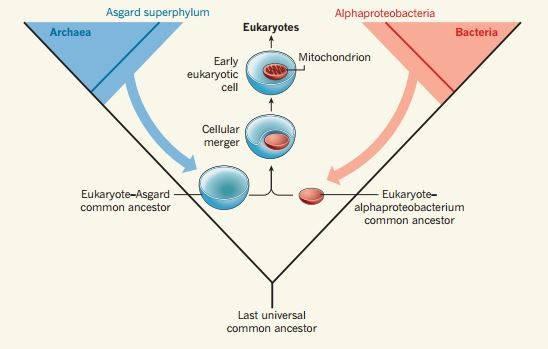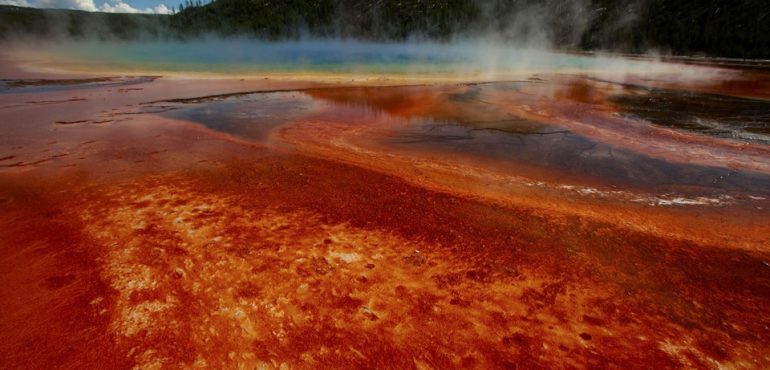If Ettema is right, then around two billion years ago, an Asgardian microbe (or an incredibly close relative) took part in a unique event that gave rise to the eukaryotes. That’s the group which includes humans, our fellow animals, plants, fungi, and every living thing made from large, complex cells—all the living things we’re most familiar with, and all the ones we can actually see. Our origins lie either in Asgard, or next door to it.
One possible answer, which I’ve written about before, says that eukaryotes were created through an incredibly unlikely merger between members of the other two domains. Somehow, a bacterium found its way inside an archaeon and, rather than being digested or destroyed, became a permanent part of its host. In doing so, it provided the archaeon with an extra source of energy, which allowed it to get bigger, accumulate more genes, and evolve down new paths that were previously inaccessible to it. That fusion cell gave rise to the eukaryotes, and the bacterium eventually turned into the mitochondria—little bean-shaped structures that still power eukaryotic cells to this day.
Once the eukaryotes evolved, they repeatedly engulf microbes and fused with them—a process called endosymbiosis. But that’s much easier to do when the host cell is already big, and can engulf smaller neighbors. If the host is an archaeon, the feat becomes much harder and far more improbable. That’s maybe why the merger between an archaeon and a bacterium—the one that gave rise to mitochondria and may have spawned the eukaryotes—has only happened once.
Loki isn’t alone. Last year, another group led by Brett Baker at the University of Texas in Austin discovered a related group of archaea in the mud of North Carolina’s White Oak River; continuing the theme, they called it Thorarchaeota. Now, by teaming up, Ettema, Baker, and others have found even more relatives in sites around the world: Yellowstone National Park, a hot spring in New Zealand, deep-sea vents lying near a Japanese island, and many more. “This work is fantastic: going out to the sediments of the planet and digging up the weird and wonderful bugs that live there,” says James McInerney from the University of Manchester.
These microbes fall into four major groups: Lokiarchaeota, Thorarchaeota, Odinarchaeota, and Heimdallarchaeota. “There’s around 50 more Asgardian gods, we’re good to go for the next few years,” says Ettema.
These four lineages all belong to an overarching supergroup that the team have called Asgard. And we eukaryotes either sit within the Asgardian family tree, or just outside it. We descend directly from either members of the group (perhaps within the Heimdall branch), or from incredibly close relatives.
This doesn’t mean that the Asgardians are eukaryotes themselves, or even anything close. As James McInernery and Mary O’Connell write, “The distribution of genes formerly thought to be eukaryote-specific is patchy,” so that no single Asgardian has “a full set.” Instead, it seems that “the building blocks for those eukaryote-defining traits were most likely already present in our archaeal ancestors,” says Ettema.
This feeds into a long-running and still unsettled debate about the origin of eukaryotes. Some scientists believe that the bacterium that would become the mitochondria was swallowed by a host cell that was already big, complex, and most of the way to becoming a eukaryote. Others hold that the host was still a true archaeon, and that it was the merger that allowed it to become more complex.
On the face of it, the presence of eukaryote-y genes in Asgard supports the former idea. But Ettema disagrees. Based on their genomes, “they’re not very sophisticated cells, but they have many of the right components in place,” he says. “They were primed to become eukaryotes.”
This debate is likely to rage on for a while, because no one has actually seen the Asgardians themselves. In the 1980s, scientists developed ways of identifying microbes by searching for their DNA amid environmental samples. This is now the main way of finding new species, but it means that many microbes—like Loki and its kin—are only known through their DNA. No one knows what they look like.
“It’s high on our priority list,” says Ettema. “It’s crucial that we have a look at the cells to see what they’re doing, but that’s extremely hard. Loki was discovered in deep-sea ocean sediments, where you don’t go every day. Thor and Heimdall are present in shallower environments, but they’re less than 0.1 percent of the total microbial community. It’s like looking for a needle in a haystack, but we’re working on it.”
Source: The Atlantic, Full Article



